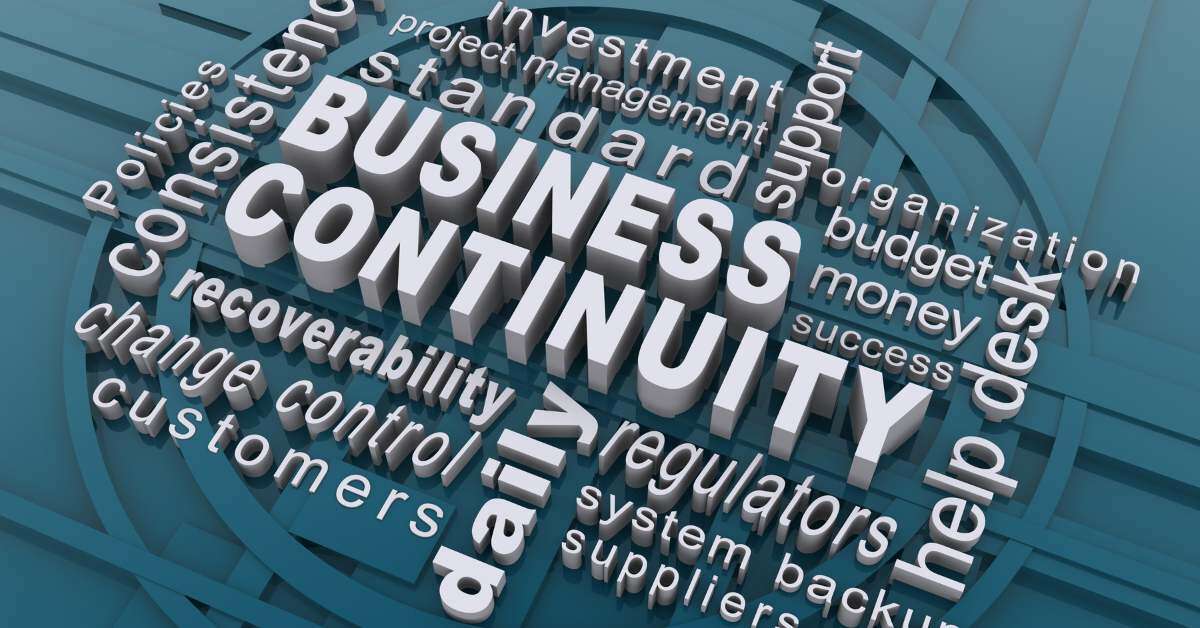
The role of business continuity and disaster recovery (BCDR) is to minimize the effects of outages and disruptions of business operations. BCDR practices enable an organization to resume operations after problems occur, reduce the risk of data loss or reputational harm, and improve operations while decreasing disruptions.
Becoming Resilient
The BCDR experts at Entech help organizations create a strategy for achieving resiliency. Developing such a strategy is a complex process that involves conducting a business impact analysis (BIA) and risk analysis as well as developing BCDR plans, tests, exercises and training.
Planning documents — the cornerstone of an effective BCDR strategy — also help with resource management, providing information such as employee contact lists, emergency contact lists, vendor lists, instructions for performing tests, equipment lists and technical diagrams of systems and networks. BCDR planning documents should be reviewed annually and whenever a business experiences a major change such as a merger, acquisition or any alteration of its business model.
An organization's ability to remain operational after an incident relies on both BC and DR procedures. The goal of BCDR is to limit risk and get an organization running as close to normal as possible after an unexpected interruption. These practices also reduce the risk of data loss and decrease the chance of emergencies, which helps maintain and even improve the organization's reputation.
Combining business continuity and disaster recovery into a single concept is the result of a growing recognition that business and technology executives need to collaborate closely when planning for incident responses instead of developing solutions in siloed isolation.
Contrasting BC and DR
Business continuity (BC) is more proactive and generally refers to the processes and procedures an organization must implement to ensure that mission-critical functions can continue during and after a disaster. This area involves more comprehensive planning geared toward long-term challenges to an organization's success.
Disaster recovery (DR) is more reactive and comprises specific steps an organization must take to resume operations following an incident. Disaster recovery actions take place after the incident, and response times can range from seconds to days.
BC typically focuses on the organization as a whole, whereas DR emphasizes the technology infrastructure. Disaster recovery is a piece of business continuity planning that concentrates on accessing data easily following a disaster. But BC also considers risk management and any other planning an organization needs to continue operations during an event.
There are also similarities between business continuity and disaster recovery. They both consider various unplanned events, from human error to natural disasters. They also share the same goal of getting the business running as close to normal again as possible, especially concerning mission-critical applications. In many cases, the same team is involved with both BC and DR.
Contrasting Business Resilience and Business Continuity
Business resilience and resiliency began appearing in the BCDR vocabulary in the early 2000s. Resilience, at times, has been used interchangeably with business continuity, but the terms have different shades of meaning.
BC, for its part, aims to help organizations maintain business-critical functions during a disaster and in its aftermath. This approach revolves around guidelines detailing what a business must do to preserve essential functions.
Business resilience, sometimes termed organizational resilience, takes a somewhat wider view. This approach emphasizes adaptability in an era of sudden and unpredictable change. An International Organization for Standardization standard, ISO 22316:2017, defines organizational resilience as "the ability of an organization to absorb and adapt in a changing environment to enable it to deliver its objectives and to survive and prosper."
Common Disruptions
 As you might guess, disruption to an organization often takes the form of natural disasters, power or internet outages, cyberattacks, theft, fire, floods, malicious destruction, supply chain disruptions, or hardware failure.
As you might guess, disruption to an organization often takes the form of natural disasters, power or internet outages, cyberattacks, theft, fire, floods, malicious destruction, supply chain disruptions, or hardware failure.
Motivation for an organization to develop a BCDR strategy might spring from the desire to protect the lives and safety of employees, ensure the availability of services to customers, and protect revenue streams. Competitive positioning and reputational management are factors that often underlie other motivators. A business perceived as unable to protect employees or deliver services will struggle to attract either workers or customers.
The regulatory and compliance environment also influences organizations in their pursuit of BCDR. The HIPAA Security Rule, for example, requires covered entities such as hospitals to provide an emergency mode operation plan, which includes "procedures to enable continuation of critical business processes for protection of the security of electronic protected health information."
Similarly, the Financial Industry Regulatory Authority (FINRA), an organization that oversees securities broker-dealers, requires such firms to "create and maintain written business continuity plans" that address emergencies or disruptions to the business. FINRA spells out its required business continuity measures in its emergency preparedness rule.
U.S. federal agencies are also required to develop BCDR strategies, which in government terminology are called continuity of operations plans. The aim is to "ensure that essential government services are available in emergencies -- such as terrorist attacks, severe weather or building-level emergencies," according to the Government Accountability Office.
Customers might also put pressure on businesses to develop adequate BCDR plans. An assessment of an organization's BCDR stance might be part of a prospective client's vetting process. Federal regulators, such as the Office of the Comptroller of the Currency (OCC), encourage banks to include resilience as part of the vendor due diligence process. Specifically, OCC Bulletin 2023-17, "Third-Party Relationships: Interagency Guidance on Risk Management," states that banks should "determine whether the third party maintains appropriate operational resilience and cybersecurity practices, including disaster recovery and business continuity plans that specify the time frame to resume activities and recover data."
Why and When
The "why" of BCDR potentially has many answers, and the "when" of business continuity and disaster recovery is similarly nuanced. Organizations must weigh several factors before declaring a disaster and triggering the BCDR plan. Chief among those is the expected duration of an outage, its effects on the organization, the financial cost of activating the BCDR plan and the plan's potential to cause disruption itself. Paradoxically, the process of relocating an organization's primary place of business to a backup facility may significantly interrupt operations.
Accordingly, an organization's leadership must carefully size up when to enact the BCDR plan. Migrating to a backup facility will likely impact revenue streams. An organization, for instance, might deem a six-hour outage not significant enough to make the disaster recovery call. That decision, particularly in larger enterprises, is typically made by a committee rather than an individual executive. The committee might consist of the CEO, CFO, CIO and other C-suite executives.
Steps to Disaster Recovery Business Continuity
Organizations that want to create a BCDR strategy can start with the following steps:
- Risk assessment and business impact analysis: Start by conducting a thorough risk assessment to identify potential threats and vulnerabilities to your business. Perform a business impact analysis (BIA) to understand the potential consequences of disruptions on your operations, revenue and reputation. Use the findings from the risk assessment and BIA to prioritize your BCDR efforts based on the criticality of systems and processes.
- Develop a comprehensive BCDR plan: Create a detailed BCDR plan that defines the procedures for responding to various types of disruptions, including natural disasters, cyberattacks and hardware failures. Define roles and responsibilities for key personnel involved in the DR and BC process, including incident response teams and communication coordinators. Establish clear escalation paths and communication channels to ensure timely coordination and decision-making during an incident.
- Implement redundancy and resilience measures: Design your IT infrastructure with redundancy and resilience in mind, leveraging technologies such as redundant hardware, data replication and cloud services. Implement failover mechanisms and automated recovery processes to minimize downtime and data loss in the event of a disruption. Regularly test and validate your BCDR capabilities through tabletop exercises, simulations and full-scale drills to identify and address gaps in your plans.
- Ensure data protection and backup: Implement robust data protection measures, including regular backups, encryption and access controls, to safeguard critical data assets. Store backup copies of data in geographically diverse locations to mitigate the risk of data loss due to regional disasters. Verify the integrity of backups through regular testing and validation to ensure they can be successfully restored when needed.
- Train and educate personnel: Provide training and awareness programs to educate employees about their roles and responsibilities in the event of a disaster. Conduct regular drills and training exercises to familiarize personnel with emergency procedures and response protocols. Foster a culture of resilience and preparedness within the organization, encouraging proactive participation and continuous improvement.
- Maintain regulatory compliance and reporting: Ensure compliance with relevant regulatory requirements and industry standards governing DR and BC practices. Maintain accurate documentation of your DR and BC activities, including policies, procedures and incident response records. Prepare for audits and regulatory inspections by keeping documentation up to date and readily accessible.
- Continuous improvement and adaptation: Regularly review and update your DR and BC plans to reflect changes in technology, business processes and threat landscapes. Incorporate lessons learned from past incidents and exercises into your planning process to enhance resilience and effectiveness. Stay informed about emerging technologies, best practices and industry trends to continuously improve your DR and BC capabilities.
How Can We Help?
The team at Entech has helped hundreds of organizations formulate detailed BCDR plans. Reach out to our team if you need expertise and guidance.
Share this entry
-
Share on Facebook
Share on Facebook
-
Share on Twitter
Share on Twitter
- Share on Google+
-
Share on Pinterest
Share on Pinterest
- Share on Linkedin
- Share on Tumblr
- Share on Vk
- Share on Reddit
- Share by Mail
Subscribe to our Newsletter
Don’t miss out on the latest news from Entech. Submit your e-mail to subscribe to our monthly e-mail list.
.png?width=360&height=300&name=Logo%20(2).png)

.jpg?width=80&height=80&name=Business%20Continuity%20Plan%20vs%20Disaster%20Recovery%20Plan_%20Whats%20the%20Difference%20(2).jpg)

.jpg?width=180&height=180&name=Business%20Continuity%20Plan%20vs%20Disaster%20Recovery%20Plan_%20Whats%20the%20Difference%20(2).jpg)





